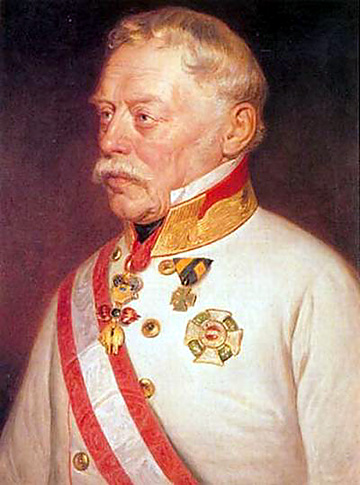Chief of the general staff of the Austrian armies against Napoleon and commanding general of Austrian forces during the revolution of 1848 in Italy. In his youth, Radetzky proved his bravery as a soldier; he was wounded numerous times, and he was noted for his intelligence and initiative. As a commander, he demonstrated concern for his soldiers and proposed innovations such as officer training schools, peacetime army maneuvers, and the use of militia (Landwehr). He hated bureaucracy and battled the rigid regulations and stagnation of the Habsburg imperial court. His strategic sense, however, led to the victories in 1813 and 1848-1849 that saved the faltering Habsburg Empire.
Radetzky was born on 2 November 1766 at Trebnice, south of Prague, on the holdings of his father, Peter Graf Euseb. He enlisted in a cuirassier regiment in 1784 and saw his first action in the war against Turkey in 1788-1789. During the French Revolutionary Wars, he led a cavalry charge at Fleurus (26 June 1794) and was promoted to captain. In 1796, he was a member of Jean de Beaulieu’s staff facing Bonaparte’s French army in northern Italy. During the War of the Second Coalition, he attained the rank of colonel and served at the Trebbia, Novi, Marengo, and Hohenlinden. In 1805, he was a Generalmajor under Archduke Charles in Italy. After assisting the archduke in reform efforts for the Austrian Army, in 1809 he commanded Feldmarschalleutnant Johann von Hiller’s rear guard. For service at and after the Battle of Wagram (5-6 July 1809), he was promoted to Feldmarschalleutnant. As chief of the general staff, he tried again to reorganize and modernize the Austrian Army, but he faced an impossible task in the face of conservative opposition in Vienna.
Before Austria joined the Sixth Coalition in 1813, the forty-six-year-old Radetzky helped to assemble and organize an army of over 200,000 men under Feldmarschall Karl Fürst zu Schwarzenberg. He authored the Trachenberg Plan (12 July 1813), which guided Allied strategy during the autumn campaign in Germany. While Allied commanders were instructed to avoid battles in which Napoleon himself commanded, they were to seize the offensive against the French emperor’s line of communications and any detached corps. This method led to Napoleon’s expulsion from Germany after the Battle of Leipzig (16-19 October).
Radetzky urged Emperor Francis I to have Schwarzenberg’s army lead the invasion of France in 1814, but Austria’s chancellor, Klemens Fürst Metternich, for political reasons, did not endorse this strategy. Radetzky was not allowed to contribute further to the overall Austrian planning. Thus, Field Marshal Gebhard von Blücher’s Prussians led the Allied advance toward Paris, prompting Napoleon’s abdication in April, while Schwarzenberg’s army crept securely along the Aube and Seine rivers.
After Napoleon’s defeat at Waterloo and his second abdication in 1815, Radetzky held minor posts in the Austrian Empire while the Habsburg army was allowed to deteriorate. However, as a result of nationalistic revolts in Italy in 1830, he was sent to quell the unrest as commanding general of Lombardy-Venetia.
He was appointed Commander-in-Chief of the Army of Upper Italy in 1831, and promoted to Field Marshal in 1836, when he was 70. Tough and vigorous despite his age, Radetzky introduced the modern concept of peacetime maneuvers so his army would always be combat-ready; his soldiers were reputedly the best-trained in Europe. His preparedness paid off in 1848 when revolution broke out throughout Italy. Radetzky crushed the uprisings with two major battles, at Custoza (1848) and Novara (1849), in both cases using brilliant tactics to defeat greatly superior numbers. He also commanded during the year-long siege of Venice and negotiated the city’s surrender in August 1849. To safeguard these victories he was appointed Governor-General of Upper Italy that same year. Radetzky’s skills as a fighter and administrator reasserted Austrian dominance of the region and set back the cause of Italian reunification by ten years. Emperor Franz Joseph finally forced him to retire at age 90 in 1857. He died in Milan a few months later and was buried at Austria’s warrior pantheon in Heldenberg. The Italians, aided by the French, made quick capital of Radetzky’s departure: in 1859 they defeated his former army and reclaimed most of the Austrian-held territories. A united Kingdom of Italy was finally established under Victor Emmanuel II in 1861. Beyond his role in military history, Radetzky is remembered for a piece of light music. To celebrate the Battle of Custoza, Johann Strauss, Sr. composed the famous “Radetzky March” (1848) in his honor. At its first performance in Vienna army officers spontaneously began to clap and stamp their feet to the chorus, and audiences since then have made this part of the work’s tradition. The “Radetzky March” is played as the customary finale to the Vienna Philharmonic’s New Year’s concerts.
References and further reading Rothenberg, Gunther E. 1982. Napoleon’s Great Adversary: Archduke Charles and the Austrian Army, 1792-1814. London: Batsford. Sked, Alan. 1979. The Survival of the Habsburg Empire: Radetsky, the Imperial Army, and the Class War of 1848. New York: Longman.
